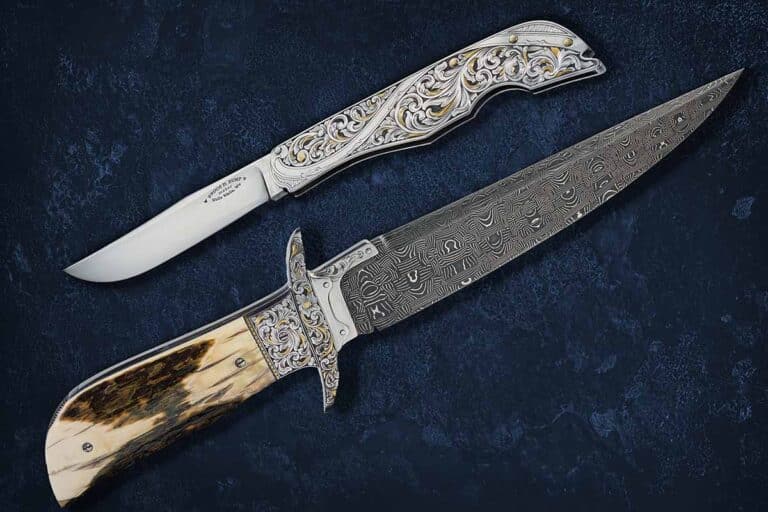
Bertram Edmonston IV overhauls his engraving resume on a Bruce Bump hideout bowie.
For the past decade, my career has primarily focused on engraving firearms, mostly Colts, Winchesters and custom 1911’s. A brief tour of my website shows the extent of the commissioned projects over the years. However, the number of significant knife-engraving commissions have been few.
In the summer of 2022, my wife, Jennifer, accepted a position with a Bechtel subsidiary located in the Pittsburgh, Pennsylvania, area. Being no stranger to relocation, I knew it would be the perfect opportunity to make a significant change in my career as an engraver.
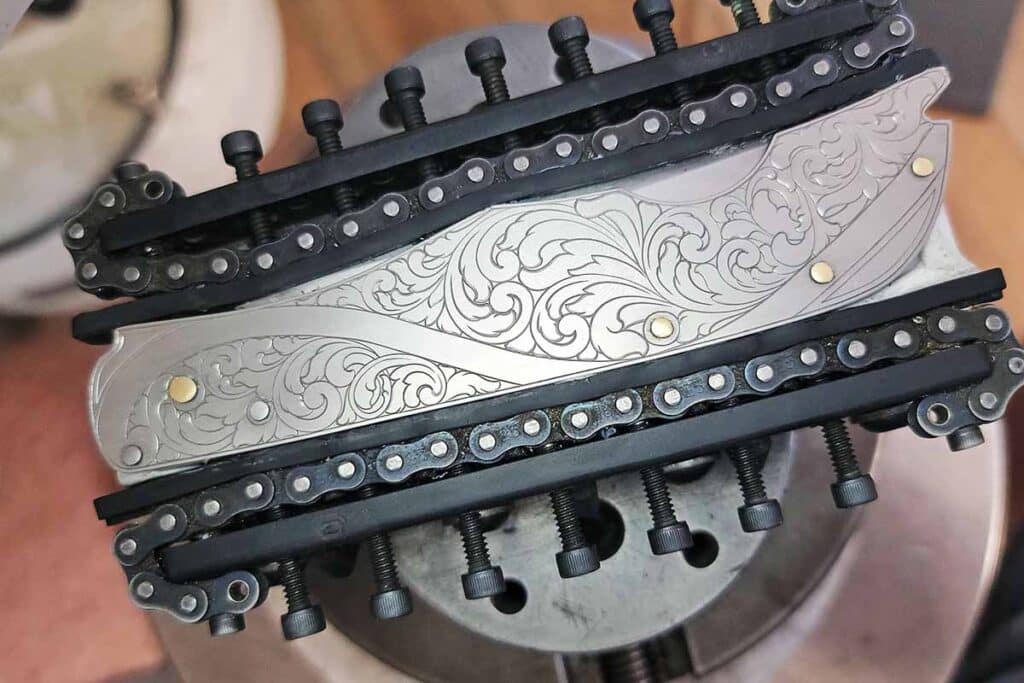
While still in Tennessee, ABS master smith Bruce Bump reached out to me to collaborate on one of his black powder percussion pistols. Bruce is a full-time bladesmith and obtained his master smith stamp in 2003.
Known for his bowies, daggers and combination black powder pistol knives—aka cut ’n shoots—he has an impressive list of accolades and award-winning creations spanning his illustrious career. In addition, he’s collaborated with many fine engravers, including his son, Brian. I was truly honored when Bruce reached out to me.
The Project
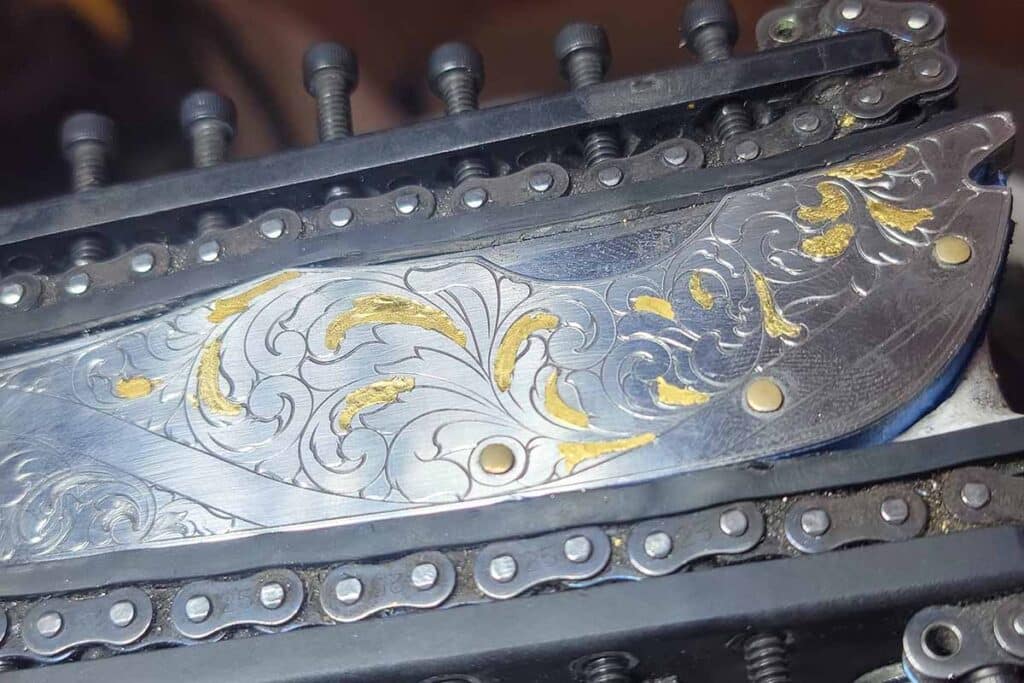
We had not met face to face but were familiar with each other’s work. We agreed to meet in person at a Nashville Arts in Metal knife show. During the meeting, he showed me one of his hideout bowies. The 15-inch knife in basketweave damascus steel immediately inspired me with its blend of high-end materials and fine craftsmanship.
Bruce forged the damascus from 1080 carbon and 15N20 nickel-alloy steels. The guard, bolster and handle frame are 416 stainless steel. The hidden slipjoint folder has a 1080 blade and 416 frame and stunning mammoth bark scales.
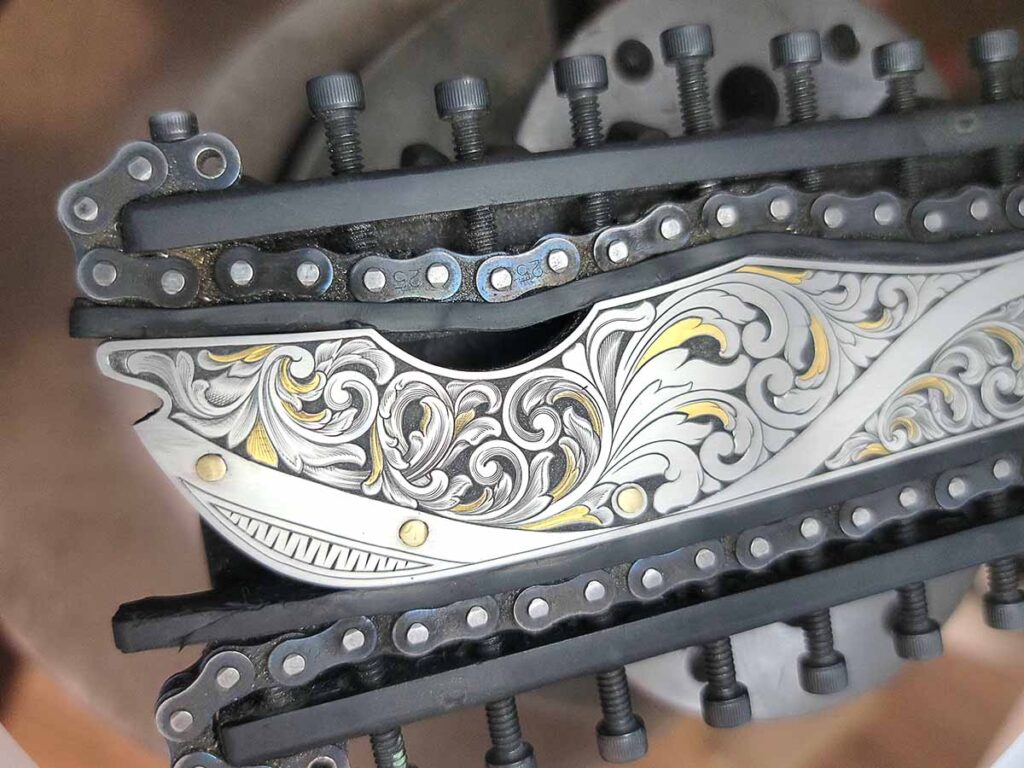
Bruce informed me the customer wanted both knives engraved and would be contacting me to discuss ideas. It took about six months to happen due to my relocation and settling into our new home.
Building a studio was my first priority. It is in a loft space over a detached garage. The space was completely unfinished when we bought the property. Excluding hanging the drywall, I did the renovation. This involved insulation, flooring, painting, trim carpentry, and heating, ventilation and air conditioning. I went from a 140-square-foot shop inside my home to an entire building with about 1,600 square feet of space.
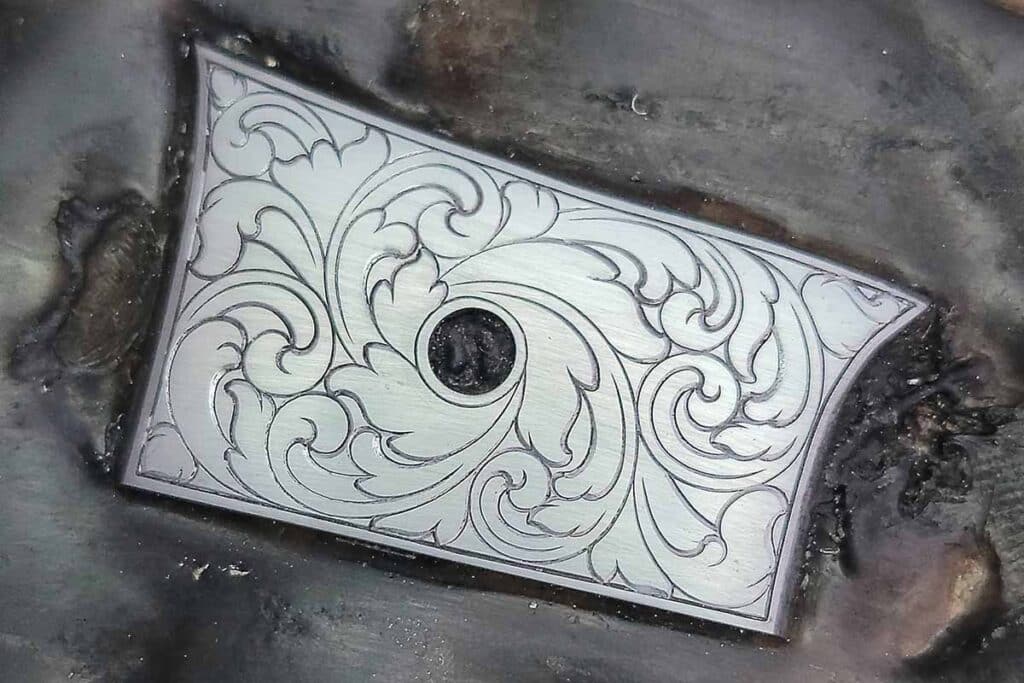
Finally—I had the room to really pursue my artistic dreams! The studio is set up with specialized workstations for all the various tasks involved in creating art in metal. After a decade of working professionally as an engraver, I learned exactly what works best for me. The primary bench is set up for the majority of my engraving with everything in arms’ reach, facilitating a comfortable and efficient workflow. In addition, there are dedicated areas for design, assembly/disassembly, welding, jewelry making, stone setting and photography.
The Knife
When the hideout bowie arrived for engraving, I spent some time admiring and studying the knife before doing anything. The damascus blade immediately impressed me. Bruce forged the basketweave pattern blade using the accordion method in which he opens up the forge-welded billet, using a spear-type point in his large hydraulic press, creating an accordion-shaped slab of metal. The process reveals the repeating pattern along the length of the billet.
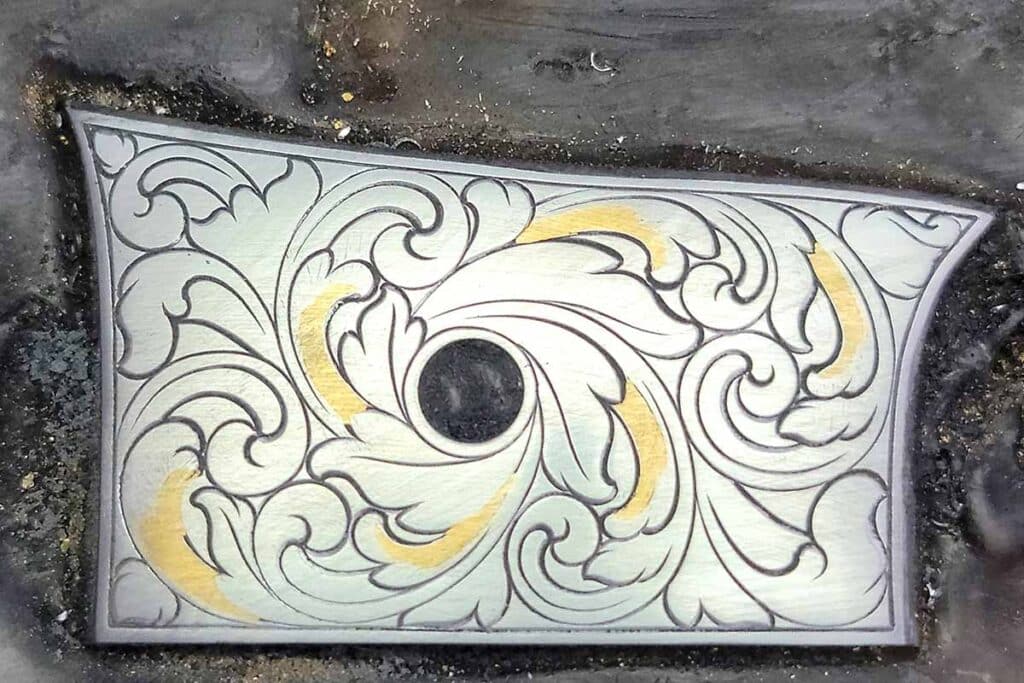
The construction of the hideout slipjoint folder is impressive as well. A flawless spring-loaded catch retains the folder inside the bowie handle. The folder has a series of small, raised pins that help locate it within the bowie handle. The pins would pose a unique challenge for me with the design and execution of the engraving.
Engraving
Much of my workflow is very old fashioned, involving traditional methods. I like to use pencil rubbings to create 1:1 outlines of the objects I’m about to engrave. The outlines are copied and duplicated to scale, allowing me to play around with the pencil to develop a pleasing composition.

Most of the time I draw the design directly on the metal, including on Bruce’s bowie and folder. I prefer this method because I understand the scale of the item better. Once one side is engraved smoke prints are taken, and a transfer is made to mirror the design precisely.
The locator pins on the folder presented a challenge, interrupting shading and flow of scroll. The solution was to embrace the pins, making them part of a simple, flowing ribbon. The ribbon was then framed with larger, relief-engraved scroll. The scroll is accented with 24k-gold inlays in the leaf structure.

There are 23 inlays on each side of the folder. There’s something magical about prime numbers and they seem to find a way into my artwork regularly. The engraving process for this style has five major stages:
Stage 1: All the scroll is engraved;
Stage 2: The inlays are prepared and the gold is set in steel;
Stage 3: The inlays are polished flush;
Stage 4: The scroll outlines are recut to make every line of the scroll perfectly crisp, and;
Stage 5: The background is carved away, textured to black, and the fine shading is engraved.
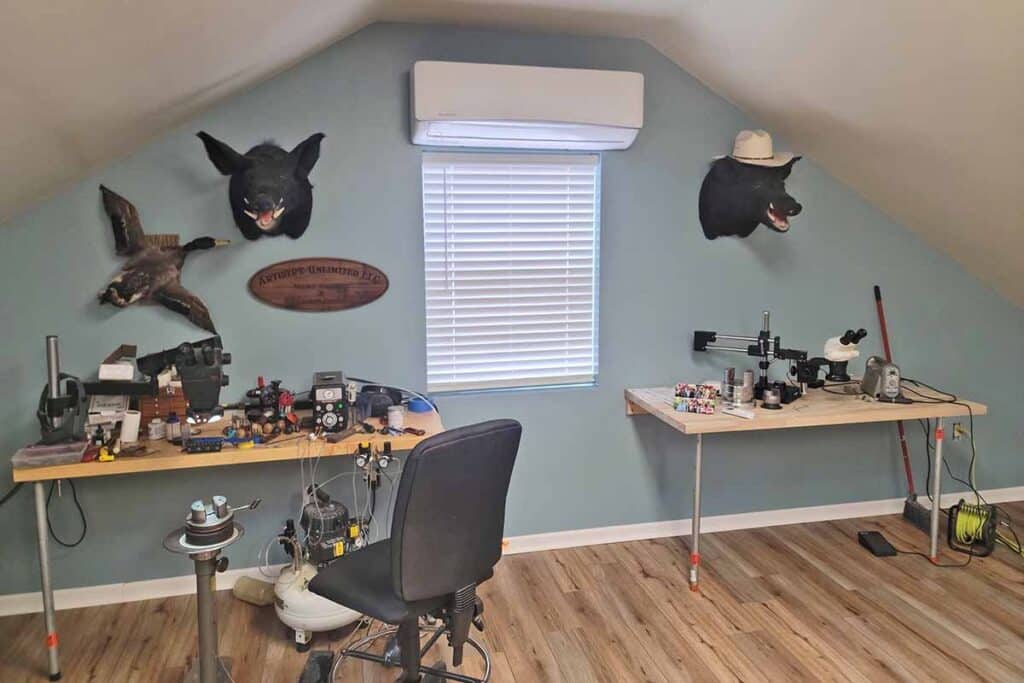
This process was repeated for the opposite side of the folder and then on the bowie knife guard and bolster. The bolster and guard also had either a pin or screw to contend with. In these areas I used them as an origin point. I also engraved the small screws to add the finishing touches to the knife.
For me, a brilliant new horizon appeared while collaborating with Bruce Bump.
More On Knifemaking:
- D.I.Y. POWER HAMMER: DO YOU REALLY NEED ONE?
- STAINLESS DAMASCUS: CHALLENGES IN FORGING
- STROPPING: WHAT IT IS AND HOW IT’S ACCOMPLISHED
- DIY ENGRAVING VISE OR BLOCK
 NEXT STEP: Download Your Free KNIFE GUIDE Issue of BLADE Magazine
NEXT STEP: Download Your Free KNIFE GUIDE Issue of BLADE Magazine
BLADE’s annual Knife Guide Issue features the newest knives and sharpeners, plus knife and axe reviews, knife sheaths, kit knives and a Knife Industry Directory.Get your FREE digital PDF instant download of the annual Knife Guide. No, really! We will email it to you right now when you subscribe to the BLADE email newsletter.






